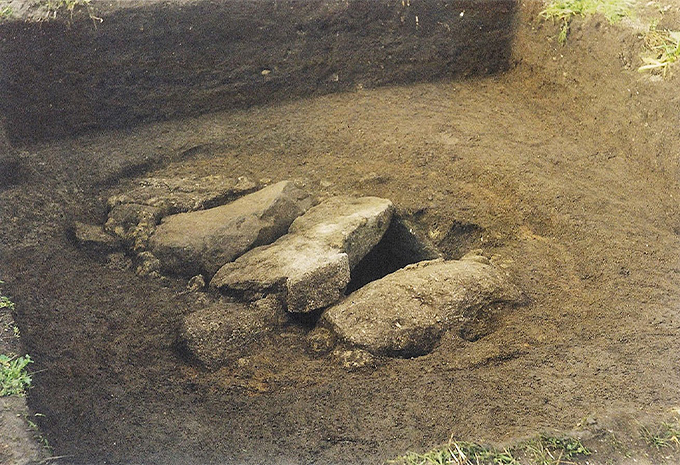Physical Address
304 North Cardinal St.
Dorchester Center, MA 02124
Physical Address
304 North Cardinal St.
Dorchester Center, MA 02124

In a remarkable archaeological find, a mysterious 2,000-year-old grave on Bryher Island, off the southwest coast of England, has raised the possibility of a woman warrior from the Iron Age. The discovery, made by a farmer in 1999 while plowing a field, has puzzled researchers due to the combination of artifacts found within the burial site.
The grave contained a mix of human tooth and bone fragments, along with a sword, shield, and bronze mirror. While swords are typically associated with male burials in the region, mirrors are often found in female burials. The presence of both items in the same grave was unprecedented in western European graves from this time period, leaving researchers uncertain about the gender of the grave’s occupant.
Biologist Simon Mays, working with Historic England, conducted a study on the remains to shed light on the mystery. By extracting protein from tooth enamel, the team was able to determine the genetic makeup of the individual. The analysis revealed that the remains belonged to a female, as the protein forms found were linked to a gene on the X chromosome, with no evidence of the presence of a Y chromosome.
Furthermore, the wear on the woman’s teeth indicated that she likely died in her early twenties, suggesting a relatively young age at the time of her burial.
The island grave, dating back to approximately 100 B.C. to 50 B.C., aligns with the Late Iron Age period. This era was marked by frequent conflicts between communities, and recent evidence has challenged the notion that only men were involved in warfare during this time. The presence of a sword in the grave suggests that the woman may have participated in raids or played a role in defending her community against enemy attacks.
One intriguing aspect of the burial is the inclusion of a bronze mirror. Researchers speculate that the mirror may have served a practical purpose beyond personal grooming. It is believed that the woman may have used the mirror to reflect sunlight as a signal to people on nearby islands and boats, potentially aiding in the planning of raids or defenses.
While the remains themselves show no signs of fighting, the presence of the sword and mirror raises questions about their significance. It is possible that these items were heirlooms passed down through generations or placed in the grave as symbols of loyalty to the woman’s family.
Further research and analysis will be necessary to gain a deeper understanding of the context and significance of this extraordinary Iron Age grave. The discovery challenges traditional notions of gender roles in ancient societies and highlights the need for continued exploration and investigation into the lives of women in the past.
The discovery of an Iron Age grave on Bryher Island in England, believed to have belonged to a possible woman warrior, has profound implications for our understanding of gender roles in ancient societies. This remarkable find challenges traditional assumptions and sheds light on the complex and diverse roles women may have played in the past.
The identification of a female burial containing a sword, shield, and bronze mirror challenges the prevailing notion that only men were involved in warfare during the Late Iron Age. This discovery suggests that women may have actively participated in raids and defended their communities against enemy attacks, expanding our understanding of the roles women played in ancient societies.
Historical narratives often focus on the experiences and achievements of men, leaving the contributions of women largely overlooked. The discovery of this Iron Age grave prompts a reevaluation of these narratives, highlighting the need to incorporate the experiences and agency of women into our understanding of the past.
By recognizing the existence of female warriors in ancient societies, we empower women’s history and challenge the notion that their contributions were limited to domestic and nurturing roles. This discovery provides a tangible example of women’s agency and resilience, inspiring a reexamination of women’s roles in other historical periods.
The identification of a possible woman warrior in an Iron Age grave underscores the importance of continued archaeological research and exploration. It highlights the potential for uncovering hidden stories and challenging preconceived notions about the past. This discovery serves as a reminder of the vast knowledge still waiting to be unearthed.
The recognition of women warriors in ancient societies has implications for contemporary discussions surrounding gender equality and representation. This discovery challenges the notion that certain roles or professions are inherently gendered, emphasizing the importance of recognizing and celebrating the diverse contributions of individuals, regardless of their gender.
The discovery of a possible woman warrior in an Iron Age grave serves as an inspiration for future generations, particularly young girls and women. It demonstrates that historical narratives can be rewritten and that women have always been capable of extraordinary feats. This discovery encourages individuals to pursue their passions and break societal barriers.
Overall, the identification of a possible woman warrior in an Iron Age grave has far-reaching effects on our understanding of gender roles, historical narratives, and the empowerment of women. It challenges preconceived notions, inspires further research, and encourages a more inclusive and diverse perspective on the past.
If you’re wondering where the article came from!
#